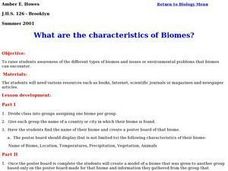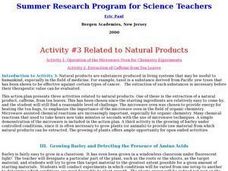Curated OER
USING the SCIENTIFIC METHOD for PROBLEM SOLVING
Young scholars work in teams to map the scientific method as applied in a present day medical situation. Their collaboration of data and findings should lead to a mutual conclusion. Students watch a variety of video's concerning these...
Curated OER
Ice Cream
Students are shown an experiment making ice cream while discovering the freezing point depression. There are questions for students to answer after the demostration.
Curated OER
Using VNTR Analysis to Identify Guilt at a Crime Scene
Students collect DNA from cheek cells. They compare and contrast the processes of DNA replication and PCR. They discuss how this information can be used to determine guilt at crime scenes.
Curated OER
How Is the Genetic Code Ultimately Translated Into a Protein?
Young scholars examine the functions of mRNA, rRNA and tRNA. They explain the steps in the protein synthesis process. They practice using new vocabulary as well.
Curated OER
What is the Anatomy of the Visual System?
Students research the structures and functions of the eye. In small groups they dissect a model of the human eye, identify structures of the eye, and describe the functions of the photoreceptors.
Curated OER
Natural Selection
Students research examples of Natural Selection on a website provided by the teacher. They experiment in groups, different processes of Natural Selection and list them on a chart provided in this lesson plan
Curated OER
How Are the Eyes of Different Organisms Adapted for Sight?
Students compare/contrast the human eye to two other organisms. They use micro viewers to identify the human eye structures, complete a Venn diagram worksheet, identify the function of each eye structure, and answer discussion questions.
Curated OER
Why is Excretion Necessary for Life?
Students describe and explain the function of each part of the excretory system. They discuss how the body uses the excretory system and identify diseases of the system.
Curated OER
Every Breath You Take
Learners study acids and bases and the uses of indicators. They interpret the actions of an indicator to conclude that bromothymol blue turns yellow in the presence of a weak acid.
Curated OER
How Do We Generate a Large Amount of a Specific DNA Sample?
Students investigate the Polymerase Chain Reaction technique that is used to create larger amounts of a gene. They watch and discuss a PowerPoint presentation, explore a website, and write a report listing the materials needed to...
Curated OER
What Are the Most Recent Developments in Animal and Human Cloning?
Students research the developments of animal and human cloning. They report their findings to the class. They write journal entries as well.
Curated OER
Identifying Food Nutrients
Students pretend they are a food-quality tester. They develop a kit to test food for sugars, starches, proteins and lipids. They answer questions to complete the lesson plan.
Curated OER
A Virtual Visit to the Microbial Zoo
Students complete a WebQuest on viruses, bacteria, and protists. They explore various websites, and answer discussion questions.
Curated OER
Autoimmune Disease
Young scholars conduct Internet research on an autoimmune disease, and present the information in a PowerPoint presentation.
Curated OER
What Are the Characteristics of Biomes?
Learners working in groups study different types of biomes and the issues or environmental problems that can affect them. They design a poster board that displays the characteristics of their biome. They make a model of the biome that...
Curated OER
Science: Conditions for Slime Mold Survival
Young scholars perform experiments to determine the nutritional needs and physical space requirements for slime mold to survive. After formulating hypotheses, they seal the petri dishes and set up the experiment along with two controls....
Curated OER
Growing Barley and Detecting the Presence of Amino Acids
Young scholars produce the greatest mass of plant material possible for 100 seeds of barley, and detect amino acids in barley plant material. They develop rules for the investigation, conduct the experiment, and prepare a computer...
Curated OER
Why Are Cells So Small?
Students examine the relationship between cell surface area and the ability of materials to diffuse through a cell. They participate in an experiment in which they determine which materials diffuse easier than others. They complete...
Curated OER
Which Household Cleaners or Soaps Work Best Against Bacteria?
Students experiment to determine the efficacy of various household cleaning products and soaps as antibacterial agents. They work in groups to complete this four part lesson series which includes identifying household bacteria,...
Curated OER
General Microbiology Lab Skills
Learners study the different types of equipment necessary for the experiments in the pGLO kit. They examine the techniques and safety procedures for working with the kit.
Curated OER
Cytoskeleton of a Cell
Students examine the cytoskeleton of a cell. They work together to build a structure with a certain number of materials. They share their "cell" with their classmates.
Curated OER
How To Culture Bacteria in the Laboratory
Students participate in an experiment in which they culture bacteria in a lab setting. They record their observations and analyze the data. They answer comprehension questions to end the lesson plan.
Curated OER
How Can We Study the Differences in Animal and Plant Cells Using the Compound Microscope?
Students examine their cheek cells with a compound microscope. They identify different parts of the cell. They compare and contrast animal and plant cells with the microscope as well.
Curated OER
Activities of the Immune System (Activity 1)
Students cut an apple in half and cover half with plastic wrap. They place drops of liquid on each half and discover how our skin protects us. They answer discussion questions to end the instructional activity.
Other popular searches
- Molecular Biology
- Plant Biology
- Biology Lab
- Biology Lesson Plans
- Biology Unit
- Introduction to Biology
- Population Biology
- Biology Crossword
- Biology Calculus
- Biology Vocabulary
- Ap Biology
- Biology Lab Photosynthesis

























